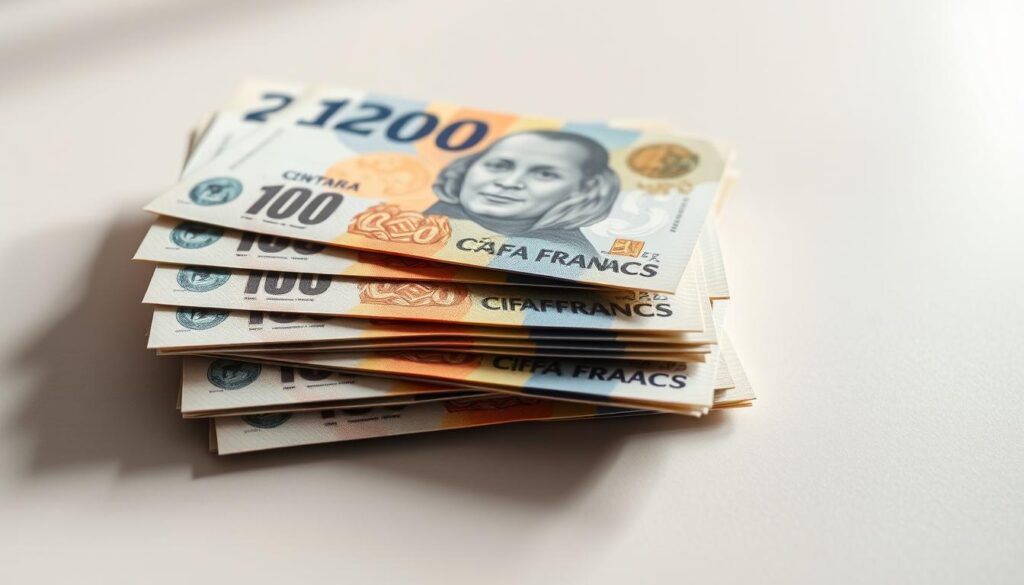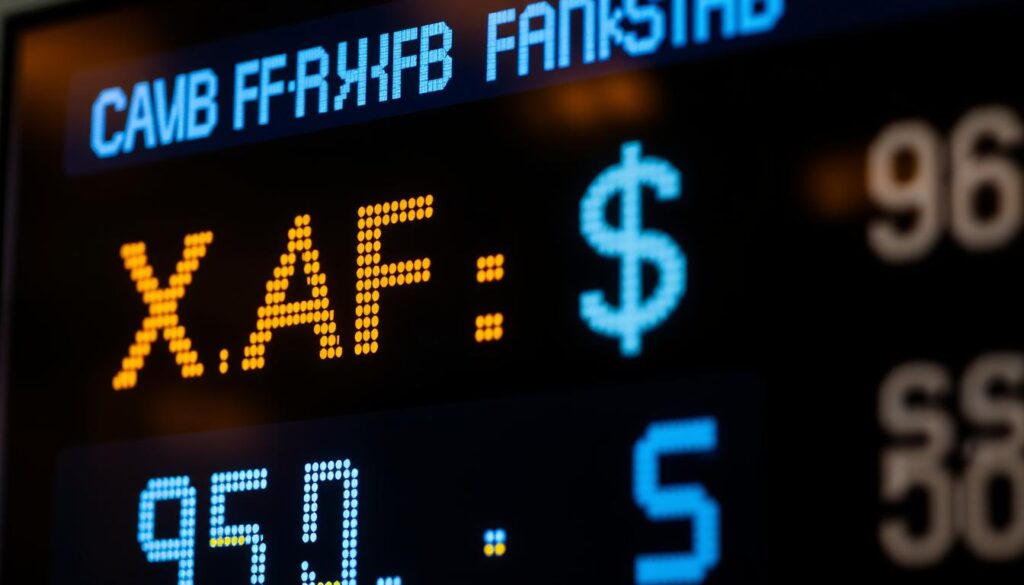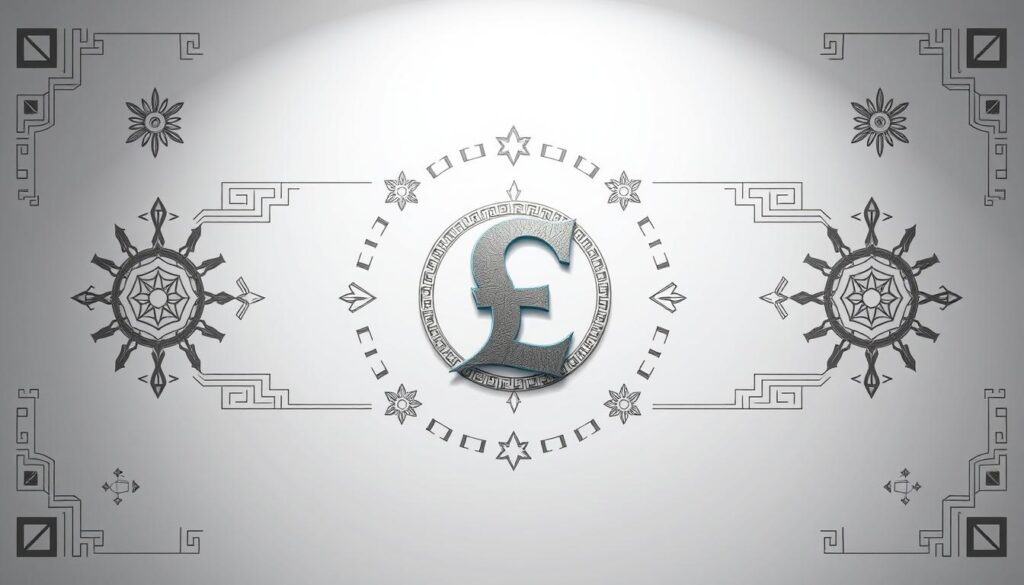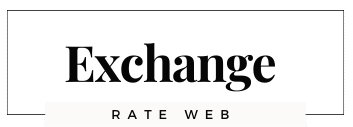
The Central African CFA Franc (XAF) is the official money of six countries in central Africa, including Chad. It has been used since 1945. Pegged to the euro, the XAF keeps the economy stable in the region. Knowing about the XAF is key for anyone dealing with Chad’s economy, whether traveling, doing business, or investing.
The XAF’s history is closely linked to the region’s colonial past and its current economy. As Chad’s economy grows, the XAF is crucial for making deals and trading.
Key Takeaways
- The Central African CFA Franc (XAF) is used by six countries, including Chad.
- Introduced in 1945, the XAF has a rich history tied to the region’s colonial past.
- The XAF is pegged to the euro, providing economic stability.
- Understanding the XAF is essential for engaging with Chad’s economy.
- The XAF facilitates transactions and trade in Chad and the broader region.
The Central African CFA Franc: Chad’s Official Currency
The Central African CFA Franc (XAF) is Chad’s official currency. It’s key to the country’s financial system. The XAF is issued by the Bank of Central African States (BEAC). This bank manages the money policy for Chad and other member countries.
Basic Facts About the XAF
The Central African CFA Franc is used by six countries in Central Africa. Its code is XAF, and it’s tied to the euro. This tie gives the region stability, which is important for Chad’s economy.
Key Features of the XAF:
- Issued by the Bank of Central African States (BEAC)
- Used by six Central African countries
- Pegged to the euro
- Currency code: XAF
The Currency’s Role in Chad’s Economy
The XAF is crucial for Chad’s economy. It helps with trade and investment. Its stability, thanks to being tied to the euro, makes economic predictions easier. This supports both local and international deals.
Chad Currency Code and International Recognition
The Chad currency code, XAF, is known worldwide. This makes it simpler for foreign investors to deal with Chad. The currency’s stability and the BEAC’s economic policies are why it’s recognized globally.
| Currency Aspect | Description |
|---|---|
| Issuer | Bank of Central African States (BEAC) |
| Currency Code | XAF |
| Pegged To | Euro |
| User Countries | 6 Central African countries, including Chad |
Historical Development of Currency for Chad
To understand Chad’s currency, we must look at its colonial past and the growth of its money system. Chad’s money history is deeply connected to its time as a French colony. This greatly shaped its currency.
Colonial Currency History
In 1945, the Central African CFA Franc was introduced as part of the French colonial money system. It was used in French colonies in Central Africa, including Chad. The CFA Franc was tied to the French Franc, making it a stable currency for colonial deals.
Post-Independence Monetary Evolution
After gaining freedom in 1960, Chad decided to keep using the Central African CFA Franc. This choice was influenced by its historical ties with France and the economic stability the CFA Franc zone offered. The currency remained tied to the French Franc until the euro replaced it in 1999.
Now, the CFA Franc is tied to the euro, giving Chad a stable currency backed by the European Central Bank. This has greatly affected Chad’s money policy and economic growth.
Key Historical Milestones in Chad’s Monetary System
Several important events have shaped Chad’s money system. The creation of the Bank of Central African States (BEAC) in 1972 was a big step in the region’s money governance. BEAC oversees the money policy of its member countries, including Chad.
| Year | Event | Impact |
|---|---|---|
| 1945 | Introduction of Central African CFA Franc | Unified currency for French colonies in Central Africa |
| 1960 | Chad gains independence | Continued use of CFA Franc for economic stability |
| 1972 | Establishment of BEAC | Centralized monetary governance for member states |
| 1999 | Pegging to the euro | Currency stability backed by the European Central Bank |
The history of Chad’s currency shows the country’s economic and political growth. From its colonial days to today, the Central African CFA Franc is key to Chad’s economy.
Understanding the CFA Franc Monetary Zone
It’s key to understand the CFA Franc monetary zone to get Central Africa’s economy. This zone includes six countries that share the Central African CFA Franc as their currency.
CEMAC Member Countries
The Economic and Monetary Community of Central Africa (CEMAC) helps its members work together economically. Six countries use the CFA Franc:
- Cameroon
- Central African Republic
- Chad
- Congo Republic
- Equatorial Guinea
- Gabon
They have a common monetary policy. The Bank of Central African States (BEAC) oversees it.
Relationship with France and the Euro
The CFA Franc is tied to the Euro, making the economies of CEMAC countries stable. This stability comes from a fixed exchange rate with the Euro, backed by France.
Key benefits include:
- Enhanced economic stability
- Increased confidence in the currency
- Facilitated trade with European countries
Monetary Policy Governance
The Bank of Central African States (BEAC) manages the CFA Franc’s monetary policy. BEAC works with other groups to keep the monetary system stable.
“The stability of the CFA Franc is a cornerstone of economic stability in the region,” said a financial expert. “The governance structure ensures that monetary policy is aligned with the economic needs of member countries.”
The governance structure checks the economy often. It makes policy changes to keep stability and growth.
Current Exchange Rates and Value Analysis
Knowing the XAF’s current value is key for doing business in Chad. The exchange rate of the Central African CFA Franc (XAF) to USD and other major currencies is very important. It affects trade, investment, and financial stability in the region.
Chad Currency to USD Conversion
The XAF to USD conversion rate changes due to many economic factors. These include inflation rates, interest rates, and Chad’s and CEMAC’s economic performance. Right now, 1 USD is about equal to 600 XAF, but this can change.

XAF Performance Against Major World Currencies
The XAF is tied to the euro, so its value is closely linked to the euro’s. This stability comes from the eurozone’s economic policies. But, it also means the XAF follows eurozone economic trends. Here’s how the XAF compares to major currencies:
| Currency | Exchange Rate (1 XAF = ) |
|---|---|
| USD | 0.0017 |
| EUR | 0.0015 |
| GBP | 0.0013 |
Factors Affecting Exchange Rates in Chad
Many things affect exchange rates in Chad. These include economic indicators, political stability, and global commodity prices. Chad’s oil exports make it very sensitive to changes in oil prices worldwide.
Oil Prices and Currency Stability
Oil prices greatly impact the XAF’s stability. When oil prices are high, Chad’s export earnings go up, making the XAF stronger. But, if oil prices fall, Chad’s earnings drop, which can weaken the currency. So, the XAF’s stability is tied to the global energy market.
Key Factors Influencing XAF:
- Global oil prices
- Economic policies of the CEMAC region
- Eurozone economic performance
- Political stability in Chad and the CEMAC region
Banking System and Currency Management in Chad
The banking system in Chad is key for the country’s economic health. It manages the Central African CFA Franc (XAF), Chad’s official currency.
Role of the Bank of Central African States (BEAC)
The Bank of Central African States (BEAC) issues the XAF and oversees the region’s money policy. It keeps the currency stable by linking it to the euro.
The BEAC’s policies aim to keep prices steady and boost economic growth. It controls the money supply, sets interest rates, and keeps the financial system stable.
Commercial Banking Infrastructure
Commercial banks in Chad offer vital financial services. They help with transactions and support the economy. Services include deposit accounts, loans, and international trade finance.
Chad’s commercial banking sector is strong, with many major banks. These banks are key in helping businesses and individuals.
| Bank Name | Services Offered |
|---|---|
| Commercial Bank Chad | Deposit accounts, loans, trade finance |
| Banque Sahélo-Saharienne | International trade finance, foreign exchange |
| Ecobank Chad | Personal banking, corporate banking |
Central Bank of Chad Currency Policies
The BEAC, Chad’s central bank, sets currency policies for stability. It manages foreign exchange reserves and oversees foreign exchange transactions.
Keeping the XAF stable is vital for Chad’s economy. It helps control inflation and supports growth. The BEAC works with other banks and the French Treasury for currency stability.
Physical Characteristics of Chad’s Currency
The Central African CFA Franc shows Chad’s culture and economy through its design. It comes in different values, both in paper and coins. Each has unique designs and safety features.
Currency Symbol and Design Elements
The Central African CFA Franc is marked with “FCFA” and has the code “XAF”. Its designs celebrate Chad’s diverse culture and key economic areas. For example, some notes show local animals, while others highlight farming, which is vital to Chad.

Security Features and Anti-Counterfeiting Measures
To fight fake money, XAF banknotes have special security features. They include watermarks, holograms, and detailed patterns. These make sure the money is real and keep trust in the system.
- Watermarks: Visible when held up to light, these are embedded in the paper to prevent counterfeiting.
- Holograms: Providing a three-dimensional image that shifts as the banknote is tilted.
- Intaglio printing: This technique gives the banknotes a raised print effect, making them harder to fake.
Banknote and Coin Denominations
The XAF comes in banknote values of 500, 1,000, 2,000, 5,000, and 10,000 francs. Coins range from 1 to 500 francs. This variety meets different needs in Chad’s economy.
The designs and safety features of these banknotes and coins are updated often. This keeps them ahead of counterfeiters and shows Chad’s economic and cultural changes.
Currency for Chad: Exchange Options and Services
Knowing how to exchange money in Chad is key for easy transactions. Chad uses the Central African CFA Franc (XAF) as its official currency. You can exchange it through different ways, each with its own benefits and things to think about.
Official Exchange Channels and Banks
In Chad, banks and approved currency exchange services are the official places to exchange money. They offer a safe and dependable way to swap currencies, following set exchange rates. The Bank of Central African States (BEAC) is crucial in overseeing these services. It ensures everything runs smoothly and follows money rules.
Some big banks in Chad that let you exchange money include:
| Bank Name | Services Offered | Locations |
|---|---|---|
| Ecobank | Currency exchange, wire transfers | N’Djamena, Moundou |
| Société Générale | Currency exchange, account management | N’Djamena, Sarh |
| Commercial Bank Chad | Currency exchange, loans | N’Djamena, Moundou |
Chad Currency Black Market Considerations
Even though official channels are safer and more reliable, Chad also has a black market for exchanging currency. Using black market services can be risky, with chances of fake money and bad exchange rates. It’s best to stick with official channels for exchanging money.
Digital and Mobile Money Services
Digital and mobile money services have changed Chad’s financial scene. Orange Money and M-Pesa make it easy and quick to manage and exchange money. These services are great for people in remote areas or those who can’t easily get to banks.
Currency Conversion Tools and Resources
For those dealing with the XAF, there are many tools and resources for currency conversion. Online sites and apps give up-to-date exchange rates. This helps you make smart choices about exchanging money and get the best rates.
Economic Implications of the CFA Franc System
The CFA Franc system has big effects on Chad and other countries. It shapes the economy in many ways.
Benefits of Currency Stability
The CFA Franc system offers currency stability, which is a big plus for Chad. This stability makes it easier to predict the economy. It helps businesses and the government plan better.
It also draws in foreign investment. Investors like a stable currency. This is especially true for Chad, with its limited resources.
Criticisms and Sovereignty Concerns
But, the CFA Franc system has its critics. They worry about monetary sovereignty. They say it limits Chad’s control over its money.
This is a big issue. Some think it slows Chad’s economic growth. It makes it hard for Chad to handle its own economic problems.
Impact on Chad’s Economic Development
The CFA Franc system’s effect on Chad’s economic development is mixed. Stability can help growth by attracting investors. But, it also limits the government’s policy options.
It also affects Chad’s trade and exports. The CFA Franc’s value can make Chad’s goods less competitive. This can hurt Chad’s trade balance.
Trade and Foreign Investment Effects
The CFA Franc system changes Chad’s trade and foreign investment. Stability makes Chad more appealing to investors. This can boost the economy.
But, the system’s impact on trade is complex. Stability helps trade, but the exchange rate can hurt exports. This affects Chad’s trade balance and economy.
In summary, the CFA Franc system has both good and bad sides for Chad’s economy. Knowing these effects is key to understanding its role in Chad’s economic future.
Recent Developments in Chad’s Currency News
Chad’s currency future is influenced by both regional and domestic factors. It’s important to understand how these changes affect the Central African CFA Franc (XAF).
Policy Changes and Monetary Reforms
There are talks about monetary reforms to make the XAF more stable and competitive. These reforms aim to modernize Chad’s money system and help it fit better into the global economy.
- Revising monetary policy frameworks to better respond to economic challenges
- Enhancing the role of the Bank of Central African States (BEAC) in monetary governance
- Exploring alternatives to the current CFA Franc system
These policy changes could greatly impact Chad’s economy. They might make it more resilient to outside shocks and help it grow economically.
Economic Challenges and Currency Stability
Despite the benefits of monetary reforms, Chad still faces economic challenges that affect its currency. Global commodity price changes, especially oil, greatly influence the XAF’s value.
Key economic challenges include:
- Managing inflationary pressures
- Maintaining fiscal discipline
- Diversifying the economy to reduce dependence on oil exports
Regional Monetary Developments
Chad’s currency is also shaped by regional monetary developments in the Economic and Monetary Community of Central Africa (CEMAC). Regional efforts to improve monetary cooperation and integration will likely affect the XAF’s stability and convertibility.
Regional developments to watch include:
- Progress towards greater monetary integration within CEMAC
- Changes in the regional monetary policy framework
- Initiatives to improve financial inclusion and stability
Keeping up with these developments is key to understanding Chad’s currency situation and future.
Practical Tips for Handling Currency in Chad
Traveling to or doing business in Chad? Knowing about currency exchange is key. The Central African CFA Franc (XAF) is Chad’s official currency. It’s important to understand the local financial scene.
Money Exchange Best Practices for Travelers
When in Chad, exchange money at banks or currency offices for a fair rate. Steer clear of airport or hotel exchanges. They often offer poor rates.
Best Practices:
- Use official exchange channels.
- Be aware of the current exchange rates.
- Avoid exchanging large amounts at once.
Currency Regulations and Restrictions
Knowing Chad’s currency rules is essential for everyone. The country has rules for bringing in and taking out money. Some transactions might be restricted.
| Regulation | Description |
|---|---|
| Currency Import | No restrictions on importing local currency, but declaration is required for amounts exceeding a certain threshold. |
| Currency Export | Export of local currency is restricted; foreign currencies can be exported within certain limits. |
Digital Payment Options in Chad
Digital payments are growing in Chad. They offer a quick and safe way to pay instead of cash. Mobile money and some credit cards are widely accepted.
Benefits of Digital Payments:
- Convenience and speed.
- Reduced risk of carrying cash.
- Increased security with PIN and authentication.
Business Considerations for Foreign Companies
Foreign companies in Chad need to know about local currency rules. Understanding exchange rates and using local banks helps manage money well. Digital payments can also be efficient.
Key Considerations:
- Compliance with local currency regulations.
- Utilizing local banking services.
- Adopting digital payment systems for efficiency.
Conclusion: The Future of Chad’s Currency
The Central African CFA Franc is key to Chad’s economy. Its history and use are deeply connected to the country’s growth. As talks about the CFA Franc’s future go on, it’s important to understand the possible paths ahead.
The future of Chad’s money is linked to talks about the CFA Franc system and possible changes. Whether Chad keeps things as they are, changes the system, or introduces a new currency, it will greatly affect the country’s economy.
Chad’s monetary system is complex, and the CFA Franc is a big part of it. The country’s economic future will depend on finding a balance between keeping money stable and gaining control over its currency.
FAQ
What is the official currency of Chad?
Chad’s official currency is the Central African CFA Franc, or XAF.
Who issues the Central African CFA Franc?
The Bank of Central African States, or BEAC, issues the Central African CFA Franc.
What is the currency code for the Central African CFA Franc?
The code for the Central African CFA Franc is XAF.
Is the XAF pegged to any major currency?
Yes, the XAF is tied to the euro. This gives it stability and predictability.
What is the CEMAC, and how is it related to the XAF?
The CEMAC is a group of six central African countries. They use the XAF as their common currency.
How does the XAF’s pegging to the euro affect Chad’s economy?
The XAF’s tie to the euro brings stability. This can attract investment and help trade. But, it also limits Chad’s control over its money.
What are the benefits of using the XAF in Chad?
The XAF offers a stable currency. This makes transactions easier and can draw in foreign investment.
Can I exchange currency in Chad?
Yes, you can exchange currency in Chad. Official places like banks and authorized services handle it.
Are there any risks associated with using the black market for currency exchange in Chad?
Yes, the black market for currency exchange is risky. You might lose money due to bad exchange rates. There’s also a chance of getting fake currency.
Are digital payment options available in Chad?
Yes, digital and mobile money services are becoming popular in Chad. They offer convenience and easy access.
What are the implications of the CFA Franc system for Chad’s economic development?
The CFA Franc system has both good and bad sides for Chad’s economy. It brings stability but might limit Chad’s control over its money.
How do oil prices affect the value of the XAF?
Oil prices can change the XAF’s value. Chad is an oil producer. So, changes in oil prices can affect Chad’s economy.
What is the role of the Bank of Central African States in managing the XAF?
The Bank of Central African States manages the region’s money policy. This includes issuing the XAF and keeping it stable.

Adam G
This post was created by Adam G, a seasoned financial writer with a passion for explaining currency exchange and market movements
